Page 1597 of 3383
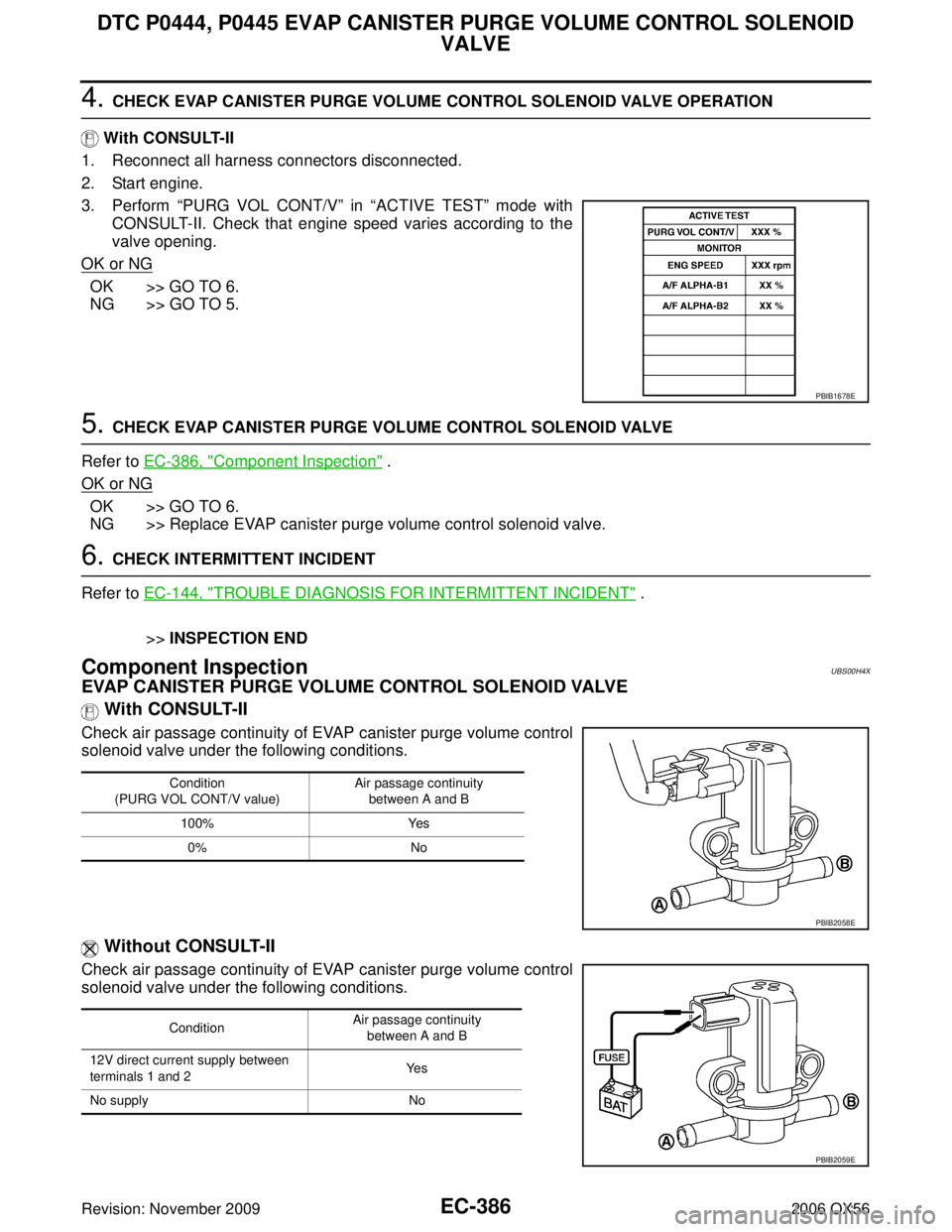
EC-386Revision: November 2009
DTC P0444, P0445 EVAP CANISTER PURGE VOLUME CONTROL SOLENOID VALVE
2006 QX56
4. CHECK EVAP CANISTER PURGE VOLUME CONTROL SOLENOID VALVE OPERATION
With CONSULT-II
1. Reconnect all harness connectors disconnected.
2. Start engine.
3. Perform “PURG VOL CONT/V ” in “ACTIVE TEST ” mode with
CONSULT-II. Check that engine speed varies according to the
valve opening.
OK or NG
OK >> GO TO 6.
NG >> GO TO 5.
5. CHECK EVAP CANISTER PURGE VOLUME CONTROL SOLENOID VALVE
Refer to EC-386, "
Component Inspection" .
OK or NG
OK >> GO TO 6.
NG >> Replace EVAP canister purge volume control solenoid valve.
6. CHECK INTERMITTENT INCIDENT
Refer to EC-144, "
TROUBLE DIAGNOSIS FOR INTERMITTENT INCIDENT" .
>> INSPECTION END
Component InspectionUBS00H4X
EVAP CANISTER PURGE VOLUME CONTROL SOLENOID VALVE
With CONSULT-II
Check air passage continuity of EVAP canister purge volume control
solenoid valve under the following conditions.
Without CONSULT-II
Check air passage continuity of EVAP canister purge volume control
solenoid valve under the following conditions.
PBIB1678E
Condition
(PURG VOL CONT/V value) Air passage continuity
between A and B
100% Yes
0% No
PBIB2058E
ConditionAir passage continuity
between A and B
12V direct current supply between
terminals 1 and 2 Ye s
No supply No
PBIB2059E
Page 1604 of 3383

DTC P0447 EVAP CANISTER VENT CONTROL VALVEEC-393
C
DE
F
G H
I
J
K L
M A
EC
Revision: November 2009 2006 QX56
6. DETECT MALFUNCTIONING PART
Check the following.
�Harness connectors E41, C1
�Harness for open or short between EVAP canister vent control valve and ECM
>> Repair open circuit or short to ground or short to power in harness or connectors.
7. CHECK RUBBER TUBE FOR CLOGGING
1. Disconnect rubber tube connected to EVAP canister vent control valve.
2. Check the rubber tube for clogging.
OK or NG
OK >> GO TO 8.
NG >> Clean the rubber tube using an air blower.
8. CHECK EVAP CANISTER VENT CONTROL VALVE
Refer to EC-393, "
Component Inspection" .
OK or NG
OK >> GO TO 9.
NG >> Replace EVAP canister vent control valve.
9. CHECK INTERMITTENT INCIDENT
Refer to EC-144, "
TROUBLE DIAGNOSIS FOR INTERMITTENT INCIDENT" .
>> INSPECTION END
Component InspectionUBS00H55
EVAP CANISTER VENT CONTROL VALVE
With CONSULT-II
1. Remove EVAP canister vent control valve from EVAP canister.
2. Check portion B of EVAP canister vent control valve for being
rusted.
If NG, replace EVAP canister vent control valve.
If OK, go to next step.
3. Reconnect harness connectors disconnected.
4. Turn ignition switch ON.
5. Perform “VENT CONTROL/V ” in “ACTIVE TEST ” mode.
6. Check air passage continuity and operation delay time. Make sure new O-ring is installed properly.
Operation takes less than 1 second.
If NG, replace EVAP canister vent control valve.
If OK, go to next step.
PBIB1033E
Condition VENT CONTROL/V Air passage continuity between A and B
ON No
OFF Yes
PBIB1679E
Page 1605 of 3383
EC-394Revision: November 2009
DTC P0447 EVAP CANISTER VENT CONTROL VALVE
2006 QX56
7. Clean the air passage (portion A to B ) of EVAP canister vent control valve using an air blower.
8. Perform step 6 again.
Without CONSULT-II
1. Remove EVAP canister vent control valve from EVAP canister.
2. Check portion B of EVAP canister vent control valve for being
rusted.
3. Check air passage continuity and operation delay time under the following conditions.
Make sure new O-ring is installed properly.
Operation takes less than 1 second.
If NG, replace EVAP canister vent control valve.
If OK, go to next step.
4. Clean the air passage (portion A to B ) of EVAP canister vent control valve using an air blower.
5. Perform step 3 again.
PBIB1033E
Condition Air passage continuity between A and B
12V direct current supply between
terminals 1 and 2 No
OFF Yes
PBIB1034E
Page 1609 of 3383
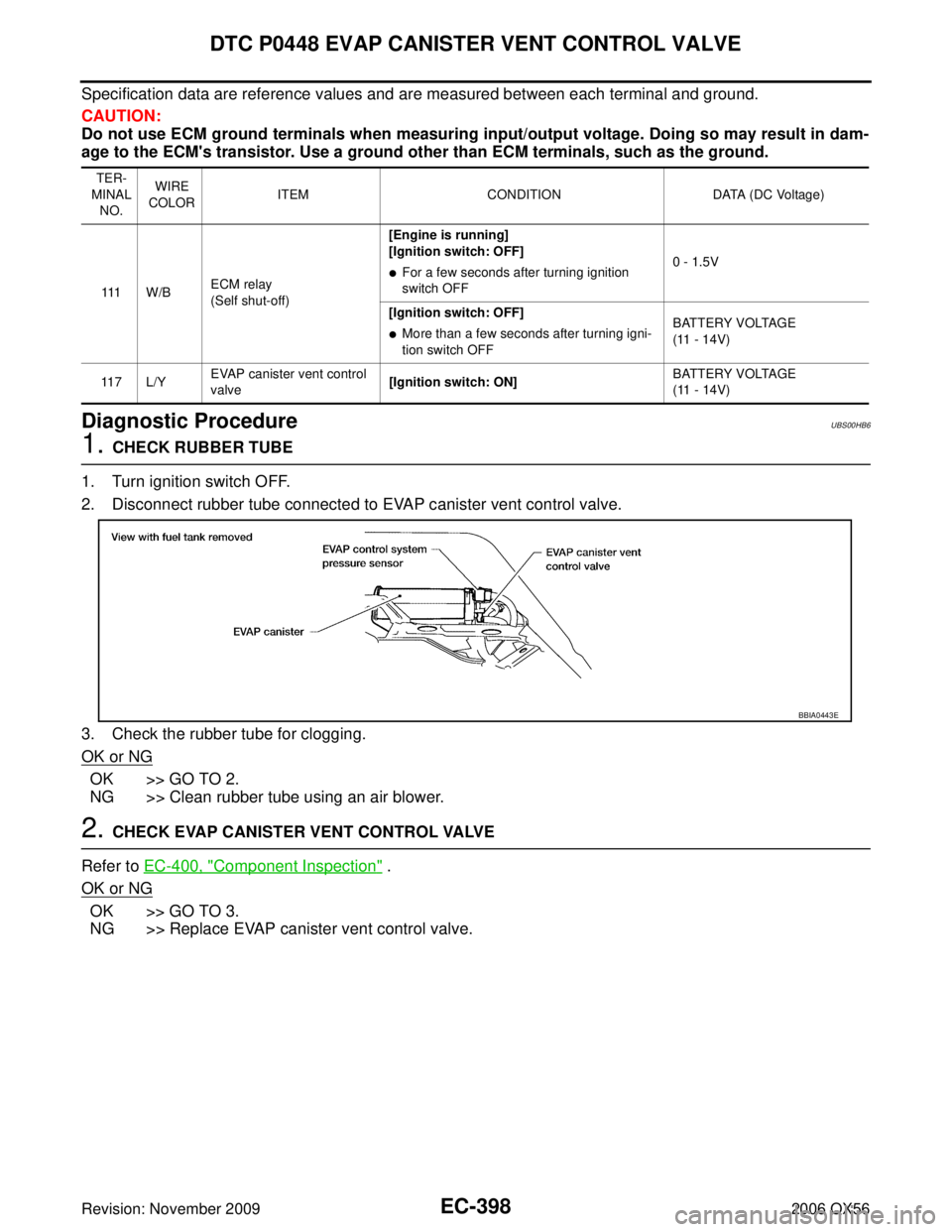
EC-398Revision: November 2009
DTC P0448 EVAP CANISTER VENT CONTROL VALVE
2006 QX56
Specification data are reference values and are measured between each terminal and ground.
CAUTION:
Do not use ECM ground terminals when measuring input/output voltage. Doing so may result in dam-
age to the ECM's transistor. Use a ground other than ECM terminals, such as the ground.
Diagnostic ProcedureUBS00HB6
1. CHECK RUBBER TUBE
1. Turn ignition switch OFF.
2. Disconnect rubber tube connected to EVAP canister vent control valve.
3. Check the rubber tube for clogging.
OK or NG
OK >> GO TO 2.
NG >> Clean rubber tube using an air blower.
2. CHECK EVAP CANISTER VENT CONTROL VALVE
Refer to EC-400, "
Component Inspection" .
OK or NG
OK >> GO TO 3.
NG >> Replace EVAP canister vent control valve.
TER-
MINAL NO. WIRE
COLOR ITEM
CONDITION DATA (DC Voltage)
111 W / B ECM relay
(Self shut-off) [Engine is running]
[Ignition switch: OFF]
�For a few seconds after turning ignition
switch OFF
0 - 1.5V
[Ignition switch: OFF]
�More than a few seconds after turning igni-
tion switch OFF BATTERY VOLTAGE
(11 - 14V)
11 7 L / Y EVAP canister vent control
valve
[Ignition switch: ON] BATTERY VOLTAGE
(11 - 14V)
BBIA0443E
Page 1611 of 3383
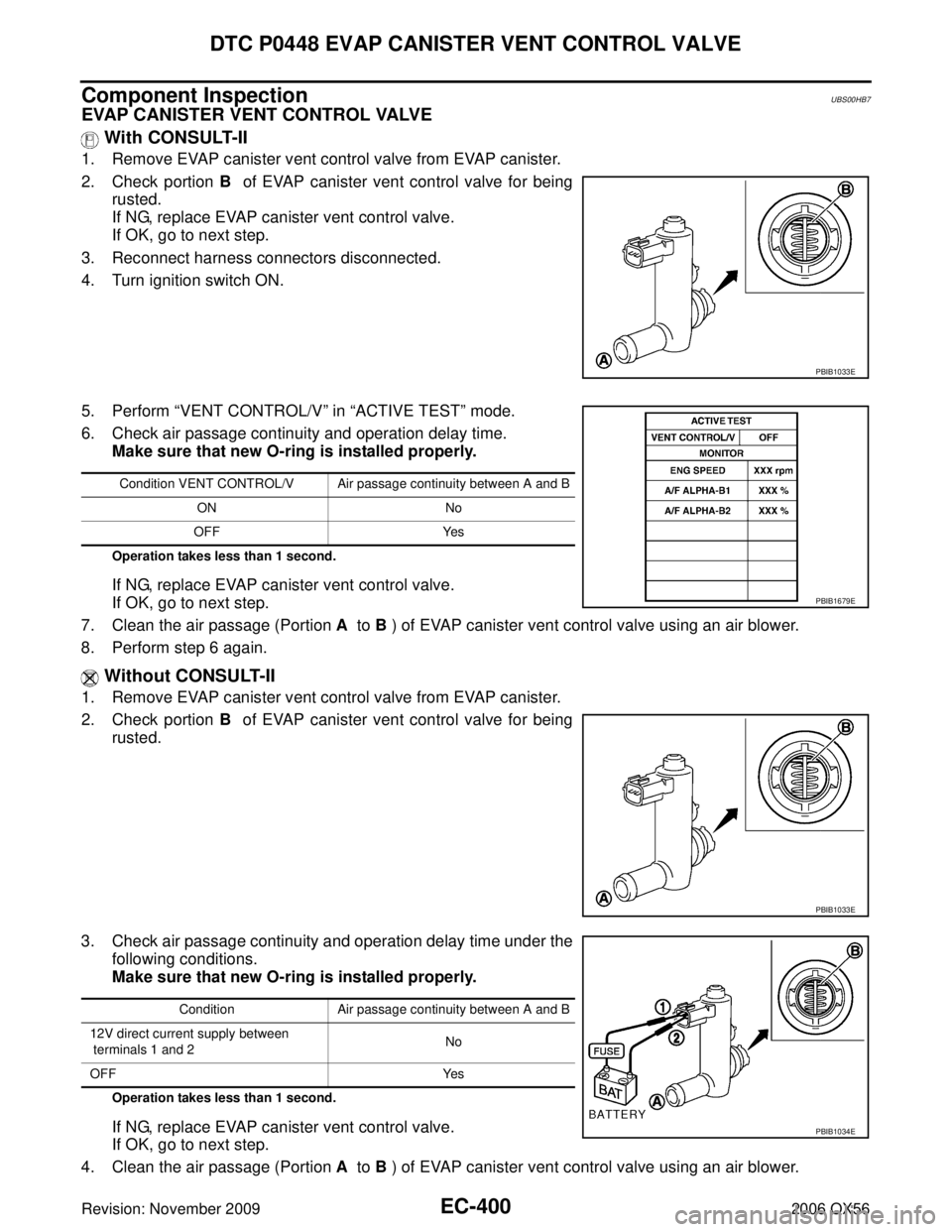
EC-400Revision: November 2009
DTC P0448 EVAP CANISTER VENT CONTROL VALVE
2006 QX56
Component InspectionUBS00HB7
EVAP CANISTER VENT CONTROL VALVE With CONSULT-II
1. Remove EVAP canister vent control valve from EVAP canister.
2. Check portion B of EVAP canister vent control valve for being
rusted.
If NG, replace EVAP canister vent control valve.
If OK, go to next step.
3. Reconnect harness connectors disconnected.
4. Turn ignition switch ON.
5. Perform “VENT CONTROL/V ” in “ACTIVE TEST” mode.
6. Check air passage continuity and operation delay time. Make sure that new O-ring is installed properly.
Operation takes less than 1 second.
If NG, replace EVAP canister vent control valve.
If OK, go to next step.
7. Clean the air passage (Portion A to B ) of EVAP canister vent control valve using an air blower.
8. Perform step 6 again.
Without CONSULT-II
1. Remove EVAP canister vent control valve from EVAP canister.
2. Check portion B of EVAP canister vent control valve for being
rusted.
3. Check air passage continuity and operation delay time under the following conditions.
Make sure that new O-ring is installed properly.
Operation takes less than 1 second.
If NG, replace EVAP canister vent control valve.
If OK, go to next step.
4. Clean the air passage (Portion A to B ) of EVAP canister vent control valve using an air blower.
PBIB1033E
Condition VENT CONTROL/V Air passage continuity between A and B
ON No
OFF Yes
PBIB1679E
PBIB1033E
Condition Air passage continuity between A and B
12V direct current supply between
terminals 1 and 2 No
OFF Yes
PBIB1034E
Page 1615 of 3383
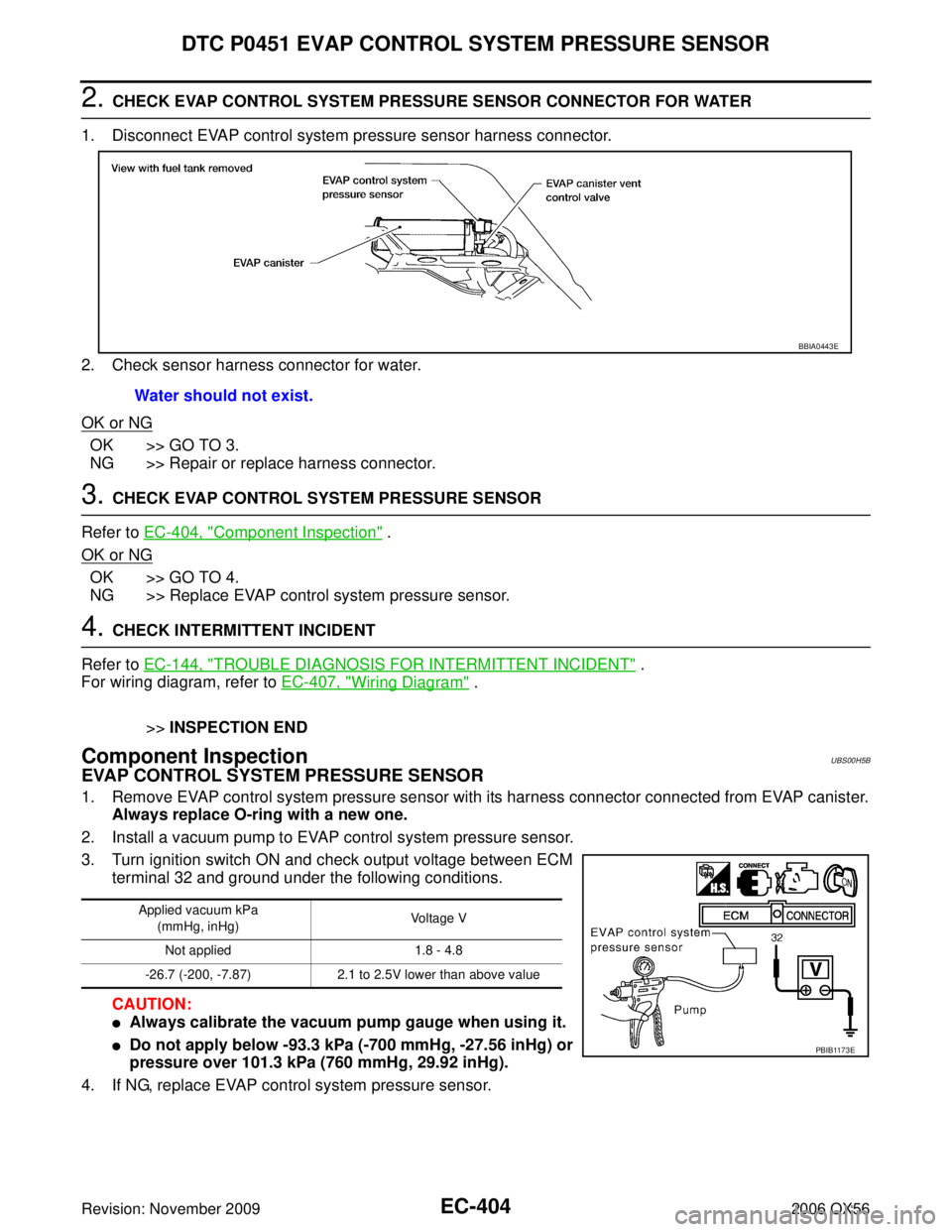
EC-404Revision: November 2009
DTC P0451 EVAP CONTROL SYSTEM PRESSURE SENSOR
2006 QX56
2. CHECK EVAP CONTROL SYSTEM PRESSURE SENSOR CONNECTOR FOR WATER
1. Disconnect EVAP control system pressure sensor harness connector.
2. Check sensor harness connector for water.
OK or NG
OK >> GO TO 3.
NG >> Repair or replace harness connector.
3. CHECK EVAP CONTROL SYSTEM PRESSURE SENSOR
Refer to EC-404, "
Component Inspection" .
OK or NG
OK >> GO TO 4.
NG >> Replace EVAP control system pressure sensor.
4. CHECK INTERMITTENT INCIDENT
Refer to EC-144, "
TROUBLE DIAGNOSIS FOR INTERMITTENT INCIDENT" .
For wiring diagram, refer to EC-407, "
Wiring Diagram" .
>> INSPECTION END
Component InspectionUBS00H5B
EVAP CONTROL SYSTEM PRESSURE SENSOR
1. Remove EVAP control system pressure sensor with its harness connector connected from EVAP canister.
Always replace O-ring with a new one.
2. Install a vacuum pump to EVAP control system pressure sensor.
3. Turn ignition switch ON and check output voltage between ECM terminal 32 and ground under the following conditions.
CAUTION:
�Always calibrate the vacuum pump gauge when using it.
�Do not apply below -93.3 kPa (-700 mmHg, -27.56 inHg) or
pressure over 101.3 kPa (760 mmHg, 29.92 inHg).
4. If NG, replace EVAP control system pressure sensor. Water should not exist.
BBIA0443E
Applied vacuum kPa
(mmHg, inHg) Voltage V
Not applied 1.8 - 4.8
-26.7 (-200, -7.87) 2.1 to 2.5V lower than above value
PBIB1173E
Page 1619 of 3383
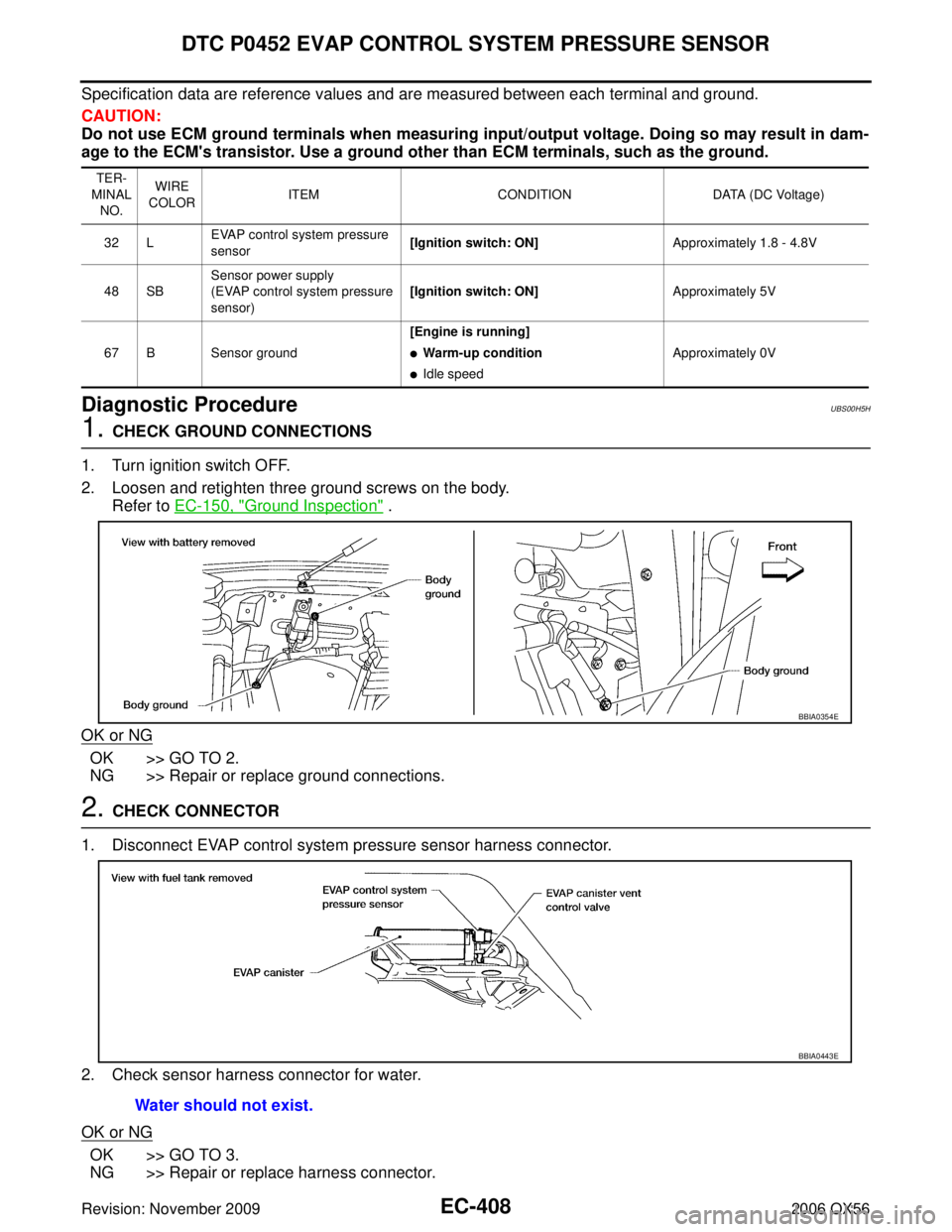
EC-408Revision: November 2009
DTC P0452 EVAP CONTROL SYSTEM PRESSURE SENSOR
2006 QX56
Specification data are reference values and are measured between each terminal and ground.
CAUTION:
Do not use ECM ground terminals when measuring input/output voltage. Doing so may result in dam-
age to the ECM's transistor. Use a ground other than ECM terminals, such as the ground.
Diagnostic ProcedureUBS00H5H
1. CHECK GROUND CONNECTIONS
1. Turn ignition switch OFF.
2. Loosen and retighten three ground screws on the body. Refer to EC-150, "
Ground Inspection" .
OK or NG
OK >> GO TO 2.
NG >> Repair or replace ground connections.
2. CHECK CONNECTOR
1. Disconnect EVAP control system pressure sensor harness connector.
2. Check sensor harness connector for water.
OK or NG
OK >> GO TO 3.
NG >> Repair or replace harness connector.
TER-
MINAL NO. WIRE
COLOR ITEM
CONDITION DATA (DC Voltage)
32 L EVAP control system pressure
sensor [Ignition switch: ON]
Approximately 1.8 - 4.8V
48 SB Sensor power supply
(EVAP control system pressure
sensor) [Ignition switch: ON]
Approximately 5V
67 B Sensor ground [Engine is running]
�Warm-up condition
�Idle speed
Approximately 0V
BBIA0354E
Water should not exist.
BBIA0443E
Page 1621 of 3383
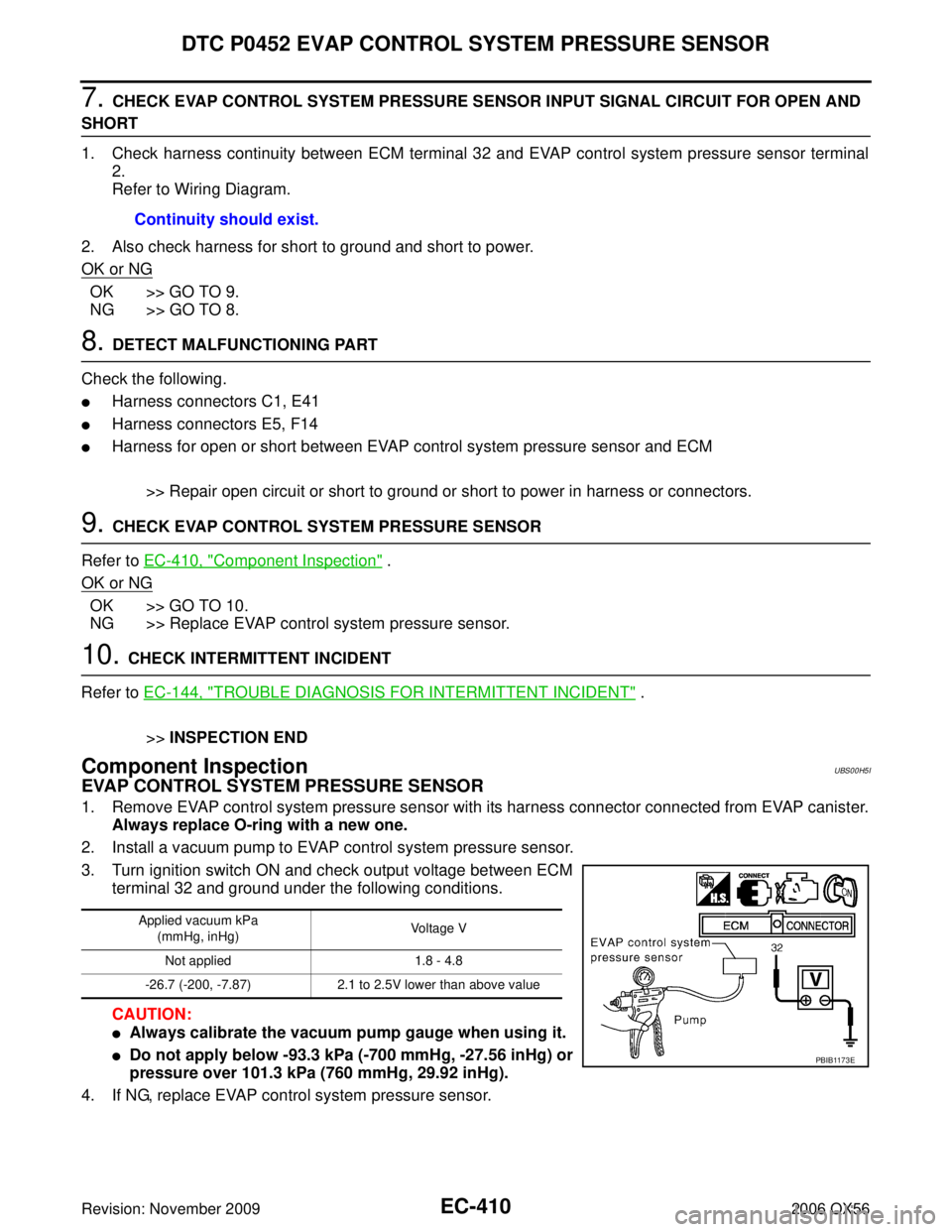
EC-410Revision: November 2009
DTC P0452 EVAP CONTROL SYSTEM PRESSURE SENSOR
2006 QX56
7. CHECK EVAP CONTROL SYSTEM PRESSURE SENSOR INPUT SIGNAL CIRCUIT FOR OPEN AND
SHORT
1. Check harness continuity between ECM terminal 32 and EVAP control system pressure sensor terminal2.
Refer to Wiring Diagram.
2. Also check harness for short to ground and short to power.
OK or NG
OK >> GO TO 9.
NG >> GO TO 8.
8. DETECT MALFUNCTIONING PART
Check the following.
�Harness connectors C1, E41
�Harness connectors E5, F14
�Harness for open or short between EVAP control system pressure sensor and ECM
>> Repair open circuit or short to ground or short to power in harness or connectors.
9. CHECK EVAP CONTROL SYSTEM PRESSURE SENSOR
Refer to EC-410, "
Component Inspection" .
OK or NG
OK >> GO TO 10.
NG >> Replace EVAP control system pressure sensor.
10. CHECK INTERMITTENT INCIDENT
Refer to EC-144, "
TROUBLE DIAGNOSIS FOR INTERMITTENT INCIDENT" .
>> INSPECTION END
Component InspectionUBS00H5I
EVAP CONTROL SYSTEM PRESSURE SENSOR
1. Remove EVAP control system pressure sensor with its harness connector connected from EVAP canister.
Always replace O-ring with a new one.
2. Install a vacuum pump to EVAP control system pressure sensor.
3. Turn ignition switch ON and check output voltage between ECM terminal 32 and ground under the following conditions.
CAUTION:
�Always calibrate the vacuum pump gauge when using it.
�Do not apply below -93.3 kPa (-700 mmHg, -27.56 inHg) or
pressure over 101.3 kPa (760 mmHg, 29.92 inHg).
4. If NG, replace EVAP control system pressure sensor. Continuity should exist.
Applied vacuum kPa
(mmHg, inHg) Voltage V
Not applied 1.8 - 4.8
-26.7 (-200, -7.87) 2.1 to 2.5V lower than above value
PBIB1173E